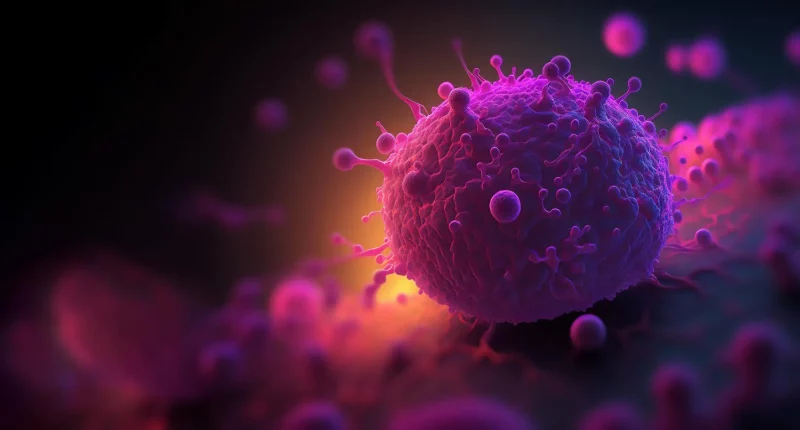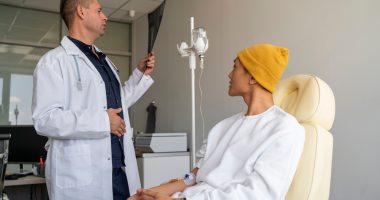Angiosarcoma is uncommon and aggressive kind of cancer that originates in the endothelial cells lining the lymphatic vessels and blood vessels. It can occur in any area of the body, but it most commonly affects the breast, skin, spleen, and liver. This malignancy is characterized by rapid development and a high potential for metastasis, making early diagnosis and treatment important for improving patient outcomes.
Signs vary depending on the tumor’s location but may include localized swelling, pain, and skin lesions that appear purplish or bruised. Treatment typically involves a combination of operation, chemotherapy, and radiation therapy though the prognosis remains challenging due to the disease’s aggressive nature.
Symptoms
The symptoms of angiosarcoma differ depending on the tumor’s place. When angiosarcoma affects the skin, it always appears as a bruise-like wound that may be dark red or purple. These wounds can be mistaken for simple wounds but do not cure and may develop over time. Skin angiosarcomas can also present as a raised, swollen area that might be painful or tender. In cases where angiosarcoma develops internally, such as in the heart or liver, symptoms may be less particular and can include extreme tiredness, unexplained weight loss, lower stomach pain, or chest pain. If the tumor is placed in the breast, it might present as a painless lump.
Causes of Angiosarcoma
The exact causes of angiosarcoma are not fully understood, but several risk factors and potential contributors have been identified:
- Genetic Factors: Changes in certain genes, such as BRCA1/2 and TP53, have been linked to a higher chance of growing angiosarcoma. These genetic abnormalities can disturb normal cell division and growth, causing cancer.
- Radiation Exposure: Previous radiation therapy, especially for breast cancer or other cancers, is a known risk factor. Angiosarcoma can occur in the irradiated area years after treatment.
- Chronic Lymphedema: Long-standing lymphedema, or swelling due to lymphatic system blockage, is associated with an increased chance of angiosarcoma. This is sometimes observed in patients who have undergone surgery or radiation for breast cancer, leading to Stewart-Treves syndrome.
- Exposure to Certain Chemicals: Occupational exposure to chemicals like arsenic, vinyl chloride, and thorium dioxide has been connected to the growth of angiosarcoma, mainly in the liver.
- Pre-existing Conditions: Certain conditions, like liver cirrhosis, can predispose individuals to hepatic angiosarcoma.
- Age and Gender: Angiosarcoma can affect individuals of any age but is more common in old aged people. There is no clear gender predilection, although some studies suggest a slightly higher incidence in males.
While these factors can increase the risk, the majority of angiosarcoma cases occur sporadically without a clear cause, highlighting the complexity and multifactorial nature of this rare cancer.
Diagnosis
Diagnosing angiosarcoma typically involves a combination of biopsy and imaging studies. Imaging modalities such as CT scans, MRI, and PET scans are used to determine the tumor’s size, place, and extent of spread. These scans can assist guide the biopsy, which is the definitive diagnostic tool. During a biopsy, a tiny tissue sample from the doubted tumor is tested under a microscope by a pathologist. Immunohistochemistry and Special staining techniques are often employed to confirm the diagnosis of angiosarcoma, differentiating it from other kinds of cancer or benign vascular tumors.
Risk Factors
Several factors increase the chance of developing angiosarcoma. Prior radiation therapy is a well-known risk factor, especially when the exposure is to high doses of radiation. Chronic lymphedema, which can occur after surgical elimination of radiation or lymph nodes, is another important risk factor. Exposure to certain chemicals, such as vinyl chloride (used in the manufacture of plastics) and arsenic, is also associated with an increased risk. Genetic predispositions, although uncommon, can play a role, as some inherited syndromes like neurofibromatosis and certain familial cancer syndromes have been connected to a higher incidence of angiosarcoma.
Treatment of Angiosarcoma
Treating angiosarcoma typically involves a combination of surgery, chemotherapy, and radiation therapy. Surgery is often the first step, aiming to eliminate as much of the tumor as possible. If the cancer is in an area that can be operated on, like the breast or skin, surgeons try to remove it completely. Radiation therapy may be utilized after surgery to kill any remaining cancer cells and decrease the chance of the cancer coming back. If the angiosarcoma cannot be entirely removed or if it has spread to other areas of the body, radiation therapy can also help shrink the tumor and relieve symptoms.
Chemotherapy is another key part of treating angiosarcoma, especially if the cancer has spread. It involves using medicines to kill cancer cells or prevent them from growing. Chemotherapy can be given before surgery to shrink the tumor, making it easier to remove, or after surgery to target any remaining cancer cells. In cases where surgery isn’t an option, chemotherapy might be the main treatment. Sometimes, doctors use targeted therapies, which are drugs that specifically attack cancer cells without harming normal cells. Each treatment plan is personalized, depending on the tumor’s size, place, and how much it has spread. Regular follow-ups are essential to monitor the patient’s progress and manage any side effects from the treatments.
Prevention of Angiosarcoma
Preventing angiosarcoma is challenging due to its rarity and the lack of specific known causes. However, reducing exposure to known risk factors can help mitigate the risk. For individuals who have undergone radiation therapy, regular follow-up and monitoring for new symptoms or changes in the skin or other tissues are essential. Managing chronic lymphedema effectively can also reduce the risk of lymphangiosarcoma. Occupational safety measures to limit exposure to hazardous chemicals like vinyl chloride and arsenic are crucial in industrial settings
Summary
Angiosarcoma is an uncommon and very aggressive cancer that starts in the cells lining blood or lymphatic vessels. Symptoms can vary a lot depending on where the tumor is placed. It can cause skin wounds that look like bruises or nonspecific symptoms if it affects internal organs. While the exact causes are not known, risk factors include previous radiation therapy, chronic swelling (lymphedema), and exposure to certain chemicals.
Diagnosing angiosarcoma involves imaging tests and a biopsy to examine the tissue. Treatment usually includes a mix of operation, chemotherapy, and radiation therapy, with new targeted and immunotherapies showing promise. Prevention focuses on avoiding known risk factors and careful monitoring of those at higher risk. Despite its aggressive nature, advances in diagnosis and treatment are helping to improve outcomes for patients with angiosarcoma.








